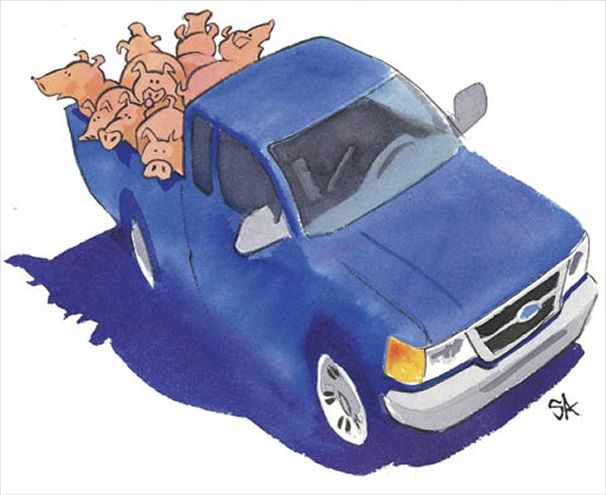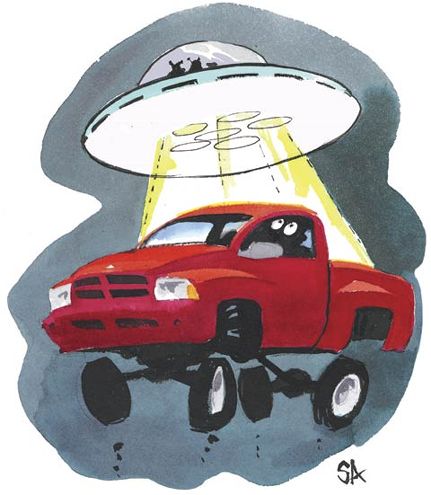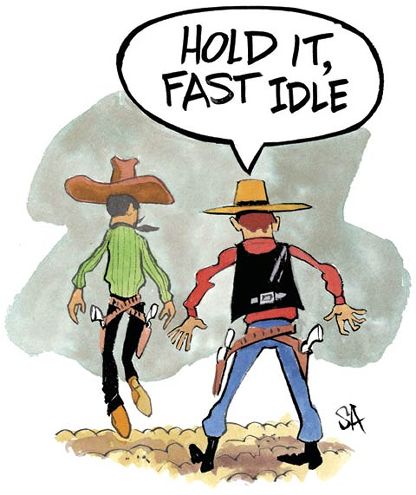Can't Find the SquealQ:I have a 2WD 1995 Ford Ranger regular-cab, longbed pickup with a 2.3-liter four-cylinder engine and five-speed manual transmission. Under part throttle in third gear between 25 and 30 mph, and again in fourth between 35 and 40 mph, it makes a squealing/whistling sound that seems to come from the engine. I was able to duplicate this noise for a technician, who thought it could be coming from the exhaust system. The following parts have already been replaced: timing belt, water pump, fan clutch, alternator, and the serpentine belt and its idler and tensioner pulleys. The noise sounds like a dry bearing squeal that only occurs under light load, part throttle at certain rpm.
A:Tracking down mystery noises can be a tough job. You've already eliminated a group of suspect parts and therefore narrowed down the list of potential causes. If the technicians working on your truck have yet to incorporate modern technology into the diagnostic process, now's the time. A Ford service department should have several tools that are invaluable in locating hard-to-find noises and vibrations. One is the ChassisEAR, an electronic listening device specializing in the detection of chassis-related noises while road-testing the vehicle. The EngineEAR can detect even the faintest noises from the engine and other attached parts such as the air-conditioning compressor or power-steering pump. There's also a handheld Ultrasonic Leak Detector that can pick up wind noise, vacuum leaks, and more. Ford service information has a detailed step-by-step procedure for categorizing and troubleshooting this type of condition. You should focus on an atypical leak or obstruction in the exhaust system, possibly in the catalytic converter. Also pay careful attention to any vacuum leaks or restrictions at the engine, leaning toward the PCV valve and hose, which are large and vulnerable sources of vacuum.
Careful Steering-Wheel RemovalQ:I need to replace my 2002 Dodge Ram 1500's steering wheel, and the current wheel doesn't have the remote control for the radio switches. My questions: First, how difficult is it to replace the actual steering wheel with respect to the airbag? Second, are the remote radio controls already wired and just need to be connected or would there be more to it than that?
A:First, and most important, the airbag system must be fully disabled by disconnecting the battery and allowing two minutes for the system to discharge. This will prevent accidental deployment and serious injury. That said, the wiring harness for the airbag and remote radio controls is connected through a "clock spring" located behind the steering wheel on the steering column. The clock spring is a wound-up group of wires that allows the steering wheel to rotate back and forth without breaking the wires. If your Dodge Ram didn't come from the factory with the remote radio option, the appropriate wiring wasn't installed and adding a steering wheel equipped with radio control switches isn't going to make it work. Replacing the steering wheel involves the removal of the airbag mounting screws, disconnecting its electrical connector, and loosening the steering-wheel retaining bolt before installing a special steering-wheel puller tool. Be sure to have the wheels straight ahead and the steering wheel centered before removal. Then mark and reinstall the steering wheel in exactly the same spot. This will keep the clock spring centered and prevent a future break in the airbag wiring.

| 163 0501 Ttg01 Z

| 163 0501 Ttg02 Z
Case of the ShakesQ:I have a Dodge Ram 1995 Quad Cab 2500 SLT with a 5.9-liter Magnum V-8. It has 80,000 miles on it. I experience a lot of vibration of the vehicle as a whole when driving at 15-20 mph, and again, but more evidently, between 60 and 65 mph. When I go faster than 65 mph the vibration disappears. What can be causing this?
A:Vibrations that vary with vehicle speed can emanate from a number of areas. As always, perform a thorough inspection of the entire suspension. Make sure nothing's loose and ready to fall off the truck. An experienced technician can usually determine a vibration's origin with a detailed road test. It may be a miss in the engine (if felt under acceleration), perhaps a driveline vibration from the driveshaft, or a familiar wheel and/or tire problem. Noticing the condition at 15-20 mph would suggest something significantly out of whack, like a defective tire or a bent wheel or axle. If the vibration persists after accurately eliminating the basics, you may want to look into Dodge Technical Service Bulletin. It involves a modified transmission mount and the reinforcement of the transmission crossmember to correct a vibration felt in the seat of your pants at various speeds. Imperfections such as "radial runout" (high and low points of the tire and wheel) and "force variation" (inconsistent stiffness of a tire) aren't correctable through traditional wheel balancing. But more advanced equipment found at most dealership service departments can alter the mounting of tires through match mounting. This positions the tire on the wheel to compensate for irregularities and therefore decrease road vibrations even further.
Beat on the DrumQ:I have 85,000 miles on a 1999 Dodge Durango and the rear drum brakes need replacing. What's the best way to release the rear drums and pull them from the vehicle?
A:The Durango uses a typical self-adjusting rear drum-brake system. Problems that can occur include the possibility that a drum has frozen to the axle or that the brake shoes have worn into the drum, creating a lip on the friction surface. Grab the drum and rock it back and forth. If it doesn't budge, it's frozen to the axle. Spray a rust-penetrant solvent at the center of the axle hub where it meets the drum. Let it soak in for a while and then rap the drum inward with a heavy hammer, working your way from side to side. In extreme cases it may not break free and will require a special drum-removal tool. Once the drum is loose on the axle, if you're still unable to pull it off, it's time to back off the self-adjuster mechanism. Remove the rubber plug behind the drum on the lower portion of the backing plate. Then insert a thin screwdriver through the hole and push the spring-loaded lever away from the star-wheel adjuster, which looks like a small-toothed gear. Then you'll need a brake "spoon" (adjustment tool) to rotate the star wheel, draw the brake shoes away from the drum, and allow removal. We hope that helps, but if the procedure's over your head, get it to a repair shop, they'll have the drums off in a flash.
Mystery Power OutageQ:I have a 2001 Dodge Ram 2500 SLT 3/4-ton 4x4 with a Cummins diesel. On two separate occasions, the entire dash went dead and a "no buss" message lit up on the odometer. Suddenly, everything went back to normal. Two trips to the dealership resulted in a best-guess diagnosis that the entire cluster panel needed replacement. I've been to several chat rooms online, and it appears others are having the same trouble and can't identify the cause.
A:Quickly establishing a clear-cut cause to an intermittent electronic failure is easier said than done, especially when it's happened only twice and can't be reproduced. There's nothing in service-manual print in reference to the 2001 Ram instrument cluster completely shutting down, so we ran it by a couple of Dodge technicians to see what they've come across. They knew of internal failures of the cluster assembly that produced the condition in question. It seems to be the most common finding in this situation, but there are a couple other causes that can mimic the symptoms. Cases of poor connections, where the wiring harness plugs in behind the instrument cluster, can interrupt a main power supply (+) or ground (-) circuit. A similar situation also has been noted at the fuse-block assembly in the dash. Both areas (and others) can intermittently kill the gauges and produce the "no buss" message. A technician should perform a thorough inspection at these locations. This can involve jiggling the wires near the connections while observing the operation of the cluster. All the connector terminals can also be visibly inspected and tightened. If the problem persists, you may have to replace the entire assembly to confirm the source.
Don't Touch that Dial!Q:I have a 1996 Chevy Z71 pickup with a 350cid engine. It idles at 800-900 rpm, which seems high. How can I find out how to adjust the idle?
A:The idle speed on the Chevy 5.7-liter V-8 engine is electronically governed by the vehicle control module, along with a number of other vital engine functions. The control module determines an optimum engine speed when you take your foot off the gas, after it analyzes data such as whether the air-conditioning is on, whether the transmission is in drive or neutral, coolant temperature, and so on. It changes the rpm by varying a small amount of air into the engine by means of an idle air control valve. The valve is mounted on the throttle-body assembly, located on top of the engine. There's no simple idle speed adjustment. It's going to require a professional diagnosis to determine a reason for the high idle. Normal idle speeds should be on or about 550 rpm in drive with an automatic or 675 rpm in neutral for a manual transmission and always checked at normal operating temperatures. Areas that need to be inspected include the throttle cable and throttle body, because each can hang up and not allow the throttle to close all the way. There can be an unwanted vacuum leak elsewhere on the engine, raising the engine speed. The idle air control valve may be defective and not doing its job, or a faulty sensor sending inaccurate data to the vehicle control module can cause a similar situation. There's a series of other possibilities that could be a lost cause trying to figure it out without the appropriate knowledge and tools.

| 163 0501 Ttg03 Z
Fast Idle TroubleshootingQ:My truck is a 2.5-liter four-cylinder five-speed 1998 Ford Ranger. This summer, it kept revving as I came to a stop. I wasn't pressing on the gas but it continued to rev, even in neutral. I don't have a tachometer to tell what rpm it reaches, but I know it sounds high. Some days my truck runs fine; however, it seems to have this problem on the hottest days.
A:The idle speed on the 2.5-liter engine is controlled by an idle air control valve mounted to the throttle-body assembly on top of the intake manifold. The IAC valve bleeds a calibrated amount of air into the engine to raise or lower idle speed when your foot's off the gas and the throttle plate is fully closed. Possible causes to high idle speeds when coming to a stop range from the throttle plate hanging up, to a sensor, such as the coolant-temperature sensor, sending incorrect data the powertrain control module. The PCM is the computer that manages many critical engine functions. Once again, it most likely will require the expertise of a qualified technician to correctly diagnose your problem. There have been similar conditions noted on certain 1998 and 1999 Rangers that have been corrected with a recalibration of the PCM (like a Windows update on your PC). Contact the dealer to see if this adjustment applies to your particular truck after all other failures of related systems have been eliminated as potential causes.
Lifted Jeep Tranny KnockQ:I own a 2003 Jeep Wrangler, to which I added a four-inch suspension lift kit and 35-inch tires. I've experienced some problems with the way the automatic transmission's shifting, so I had the service department at the dealership reprogram it, which was a notable improvement. I still sense some hesitation when I move to reverse, especially when on an incline. At times it won't catch and I need to shift it back to neutral, then it seems to slam into gear. I had the transmission and pan looked at and there weren't any shavings. Any ideas?
A:I pulled up Jeep Technical Service Bulletin. This repair is in reference to a delayed or temporary loss of transmission engagement after initial startup. There may also be a notably harsh downshift from fourth to third gear. The procedure consists of a software revision to the Transmission Control Module (the computer that controls automatic-transmission operation) in addition to replacement of the transmission's front pump assembly (the heart of the transmission, which supplies hydraulic pressure). The Jeep service department technician who worked on your Wrangler revised the software, but failed to replace the pump. This would've been the appropriate repair, according to an additional service bulletin, if the harsh 4-3 downshift was the only symptom. In your case, the pump should've also been replaced after all other related components were eliminated as causes to the delayed engagement. Take it back to the dealer, noting the appropriate service bulletin, and hopefully they'll complete the repair by replacing the pump and thus solve your problem.
How To Reach AlexIf you have a technical question regarding your pickup, SUV, or van, feel free to contact Alex, a master technician with the National Institute for Automotive Service Excellence. Send a letter to him in care of Truck Trend Garage, 831 S. Douglas Street, El Segundo, CA 90245, or e-mail us at trucktrend@sourceinterlink.com. Please include the VIN with your question. Due to the volume of questions received every month, we cannot guarantee that everyone's question will be personally answered or will appear in the magazine.
Can't wait for help with a problem you're having with your Truck or SUV? Ask the expert we trust here at Truck Trend Garage--visit Alex Steele at www.RealWorldAutomotive.com.

| 163 0501 Ttg04 Z
 | 163 0501 Ttg01 Z
| 163 0501 Ttg01 Z
 | 163 0501 Ttg02 Z
Case of the Shakes
| 163 0501 Ttg02 Z
Case of the Shakes | 163 0501 Ttg03 Z
Fast Idle Troubleshooting
| 163 0501 Ttg03 Z
Fast Idle Troubleshooting | 163 0501 Ttg04 Z
| 163 0501 Ttg04 Z